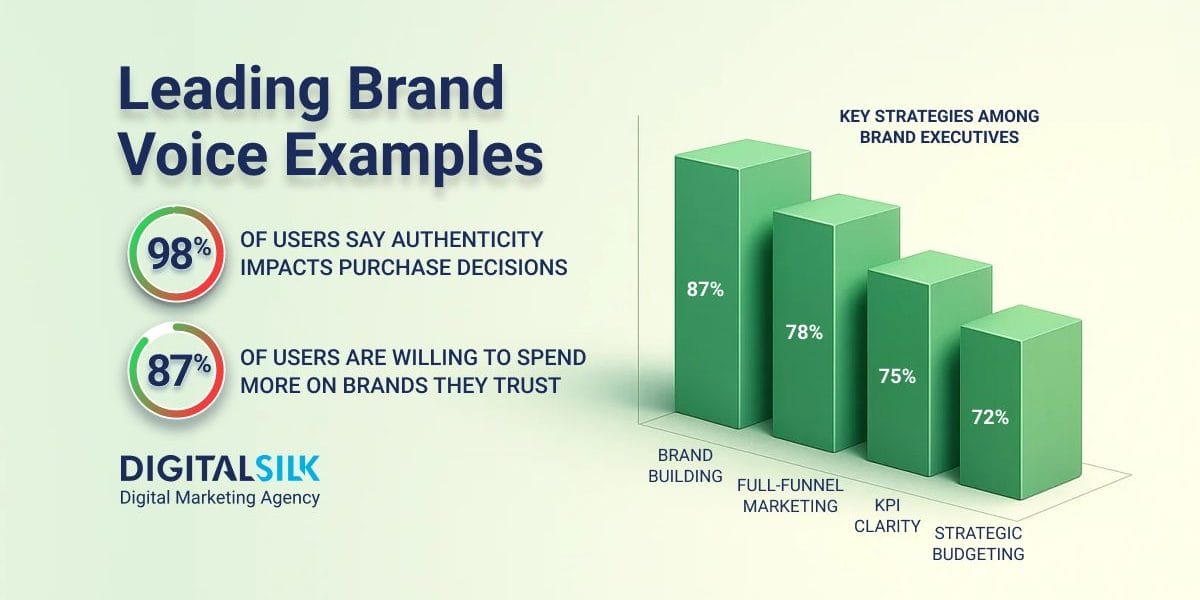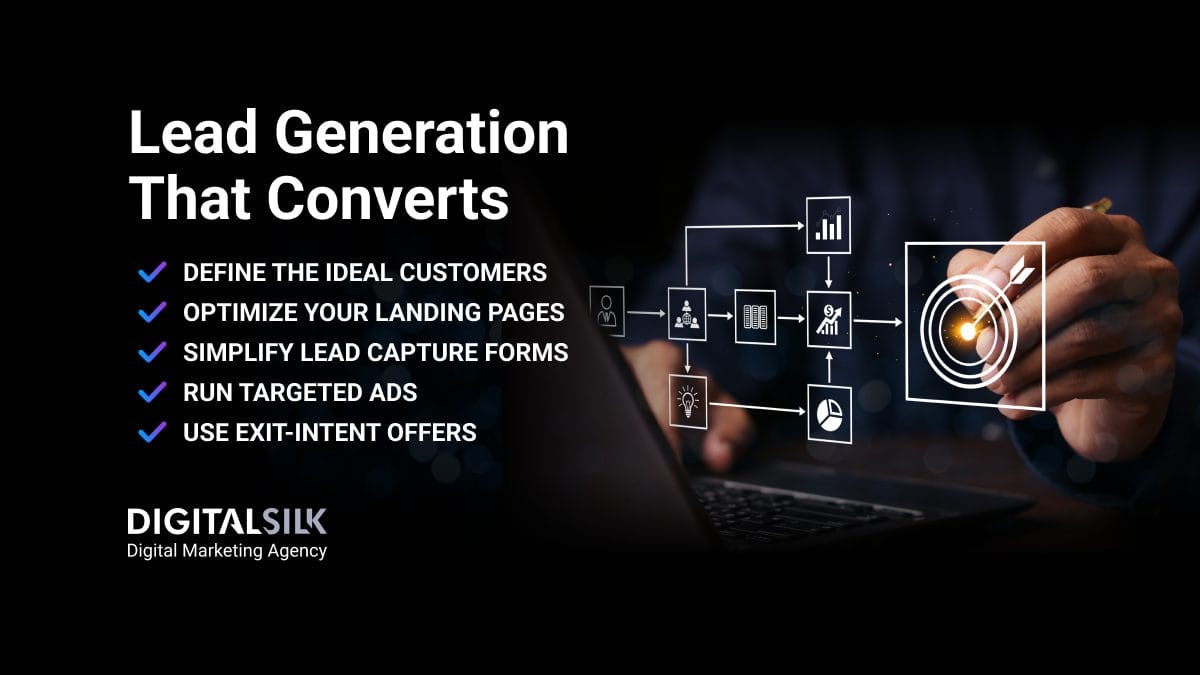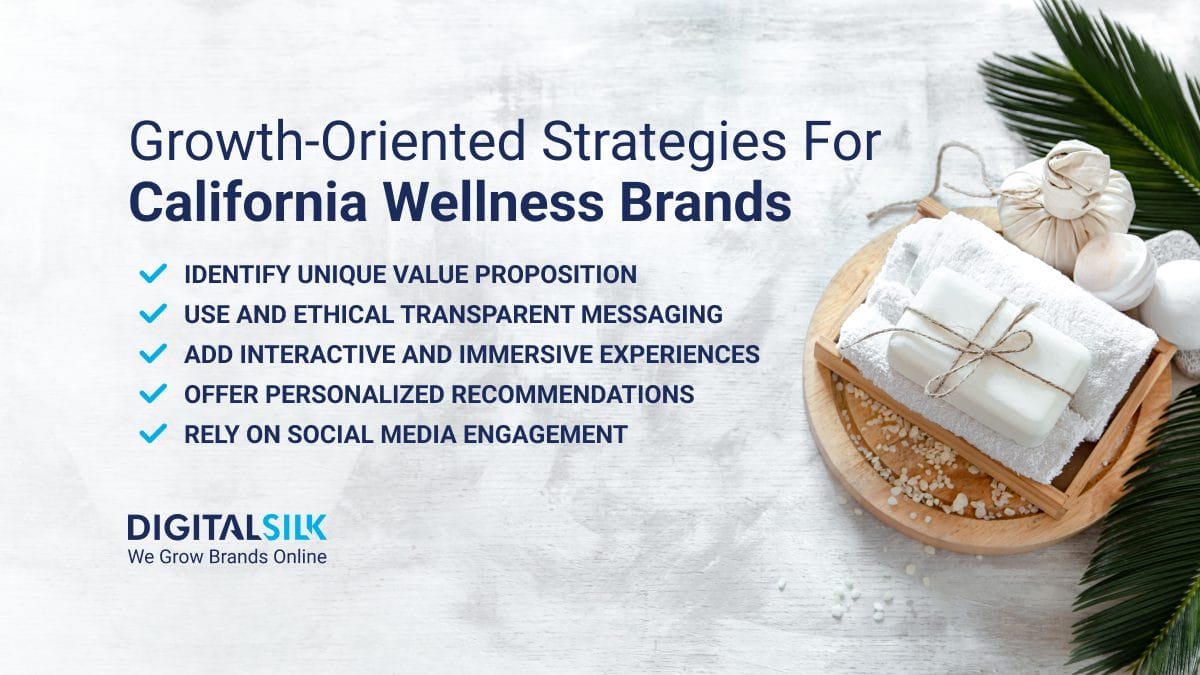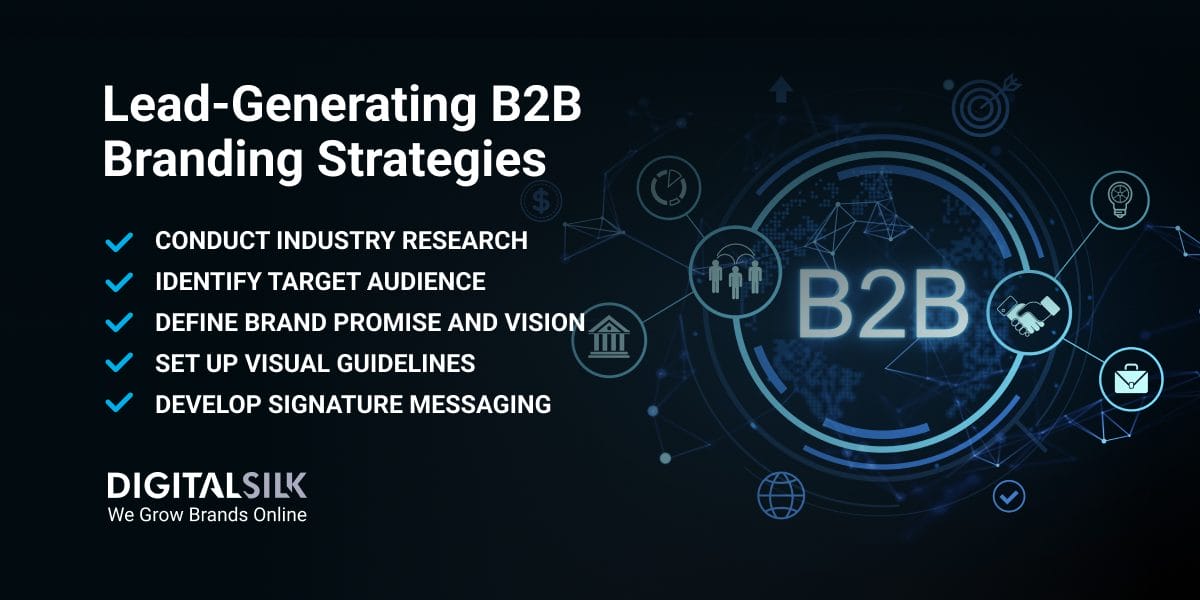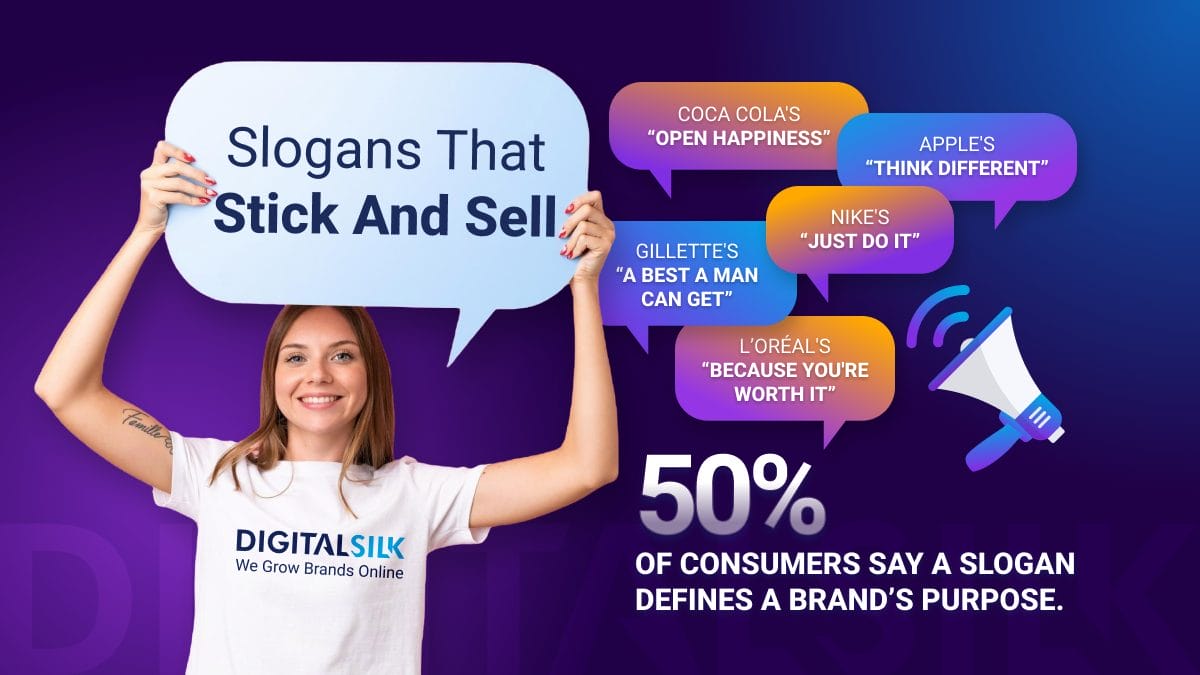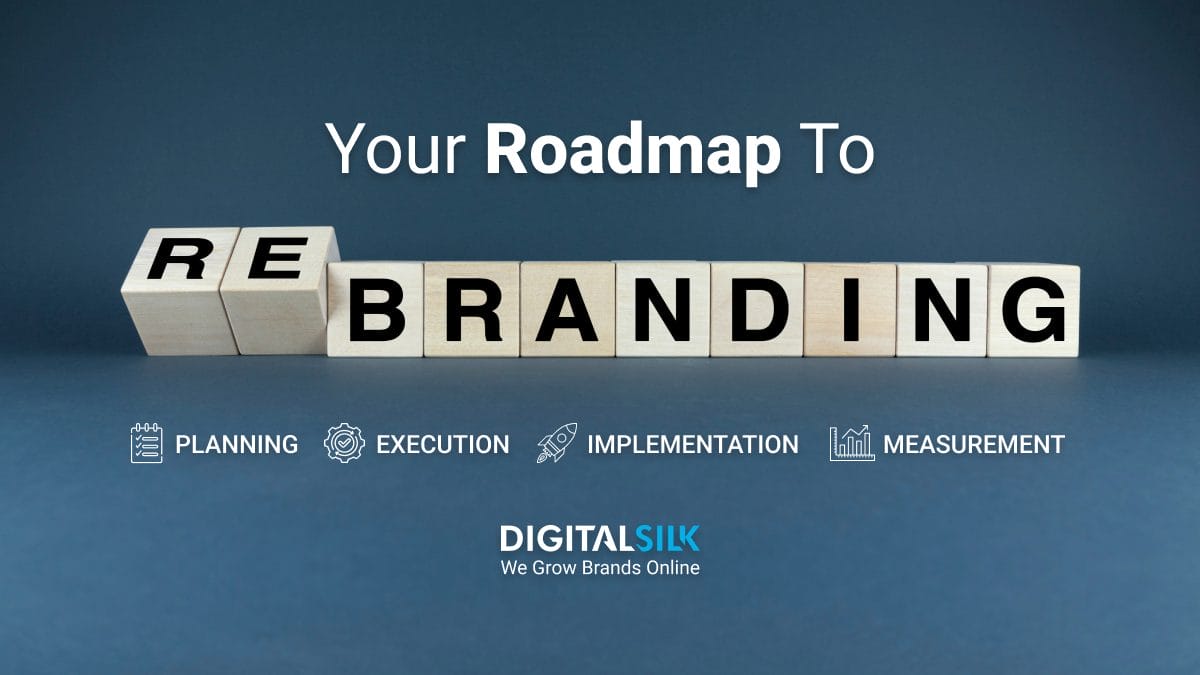Brand Voice: Key Highlights
-
Voice shapes perception: A distinct tone builds emotional connection and keeps your brand top of mind.
-
Consistency builds credibility: When your brand sounds the same across platforms, it signals professionalism and earns trust.
-
Voice reflects values: How you communicate reveals what your brand believes, shaping deeper audience connection over time.
Every brand tells a story, but only the ones with a distinct voice earn a place in people’s minds.
With 87% of executives ranking brand-building as a top priority, shaping a recognizable voice becomes less of a marketing tactic and more of a leadership decision.
A strong voice goes beyond words and stories to resonate with consumers in ways that drive trust, loyalty and long-term growth.
In this post, we’ll explore 15 brand voice examples that show how companies define their identity in crowded markets, maintain consistency across every touchpoint and build the kind of familiarity that keeps them top of mind.
15 Brand Voice Examples To Shape Your Strategy
80% of customers say the experience a company provides matters as much as its products and services.
The 15 brand tone of voice examples below highlight companies that use language with consistency, originality and alignment to their core identity.
Each one shows how a distinct voice can communicate values, build recognition and create an emotional connection with consumers.
1. Fenty Beauty
Fenty Beauty communicates in a bold and unapologetic voice that reflects the vision Rihanna set when she created the brand that’s centered on inclusivity, mutual acceptance and self-expression.
The tone is conversational yet deliberate, creating a recognizable voice that consumers connect with on a personal level and see as authentic.
With 87% of consumers saying they are more likely to spend more on brands they trust and that number climbing to 90% among millennials, Fenty’s approach shows how voice directly translates into loyalty and revenue.
This inclusive mindset runs through campaigns, product development and community engagement, turning trust into both measurable growth and cultural influence.
2. Dove
Dove has built its brand voice and tone around empowerment, using language that encourages people to embrace their own definition of beauty.
Instead of centering on product features, the brand consistently communicates themes of body positivity, self-worth and confidence, which resonate far beyond traditional marketing.
This approach turns every campaign into both a message and a movement, reinforcing Dove’s values while strengthening trust with its audience, improving positioning and expanding consumer advocacy.
3. Apple
Apple’s brand voice guidelines shape a tone that is as distinctive as its design philosophy.
The company communicates through short, confident statements that highlight innovation while keeping technology clear and approachable.
The voice balances enthusiasm with authority, reinforcing Apple’s reputation for leadership in both design and engineering.
This disciplined approach to communication helped Apple become the most valuable brand in the world in 2024, valued at $1.015 billion, showing how consistent voice strengthens market influence and long-term brand equity.
4. Disney
Disney’s voice is built on wonder and optimism, creating stories that invite people of all ages into a world where imagination feels limitless.
This tone extends beyond films and advertising into parks, merchandise and every interaction that carries the Disney name.
71% of Americans say they are more likely to buy from brands connected to childhood memories, which shows how the brand’s nostalgic storytelling translates into both emotional resonance and commercial strength.
Disney is one of the examples of brand voice that reinforces values of joy, inclusivity and timeless connection, turning shared memories into loyalty that spans generations.
5. Oatly
Oatly’s brand voice thrives on humor and irreverence, with messaging that feels more like a conversation than corporate communication.
The now-iconic line “Wow, no cow” began as a 2014 campaign where CEO Toni Petersson sang his own song to explain the brand’s purpose, a moment that captured the playful spirit still woven through Oatly’s identity.
Cartons, ads and social copy continue this approach with witty, unconventional language that makes the brand instantly recognizable.
With 98% of consumers reporting that authenticity influences their buying decisions, Oatly’s consistent voice shows how originality and transparency can build trust and loyalty.
6. Duolingo
Duolingo has turned its brand voice into a cultural asset, brought to life through Duo the owl, a character that embodies the company’s playful yet persistent approach to learning.
The tone is intentionally lighthearted, slightly awkward at times, but always encouraging, which makes the process of practicing a language feel approachable rather than intimidating.
This consistency is supported by detailed brand voice guidelines, where Duolingo even defines its personality through comparisons to celebrities, vehicles and music.
7. Slack
Slack approaches brand voice development with the same intent it applies to its product: to simplify communication and make it feel more human.
Its voice is casual but purposeful and sounds like a thoughtful coworker who communicates with empathy and practicality.
Guidelines extend beyond tone into rules for style, copy principles and even the use of emojis, so that every interaction reinforces consistency and trust.
With 54% of consumers believing brands should focus less on selling and more on supporting their customers, Slack’s communication aligns with that expectation by emphasizing guidance, collaboration and user experience over hard sales.
This consistency turns everyday interactions into proof of Slack’s role as a partner in productivity rather than just another tool.
8. HubSpot
A clear brand voice guide allows HubSpot to communicate in a way that is actionable, supportive, informative and growth-oriented, aligning closely with its mission to help businesses achieve sustainable results.
Its communication style is approachable and authoritative, offering insights that audiences can apply directly to their marketing and sales challenges.
Cultural awareness is embedded into its communication, illustrated by a post that compared mercury retrograde to the frustration of a messy sales pipeline.
With 64% of consumers wanting brands to connect with them, HubSpot demonstrates how expertise combined with relatability strengthens customer relationships and reinforces long-term growth.
9. Title Nine
A brand voice that is friendly, direct and playful builds instant relatability, especially when it speaks to the everyday realities of its audience.
Instead of polished marketing jargon, Title Nine leans into humor and honesty, as seen in a swimsuit ad promising designs that are “wedgie proof” with “no nip slips.”
This kind of language shows that Title Nine understands the lived experiences of the women it serves and communicates as a peer rather than a seller.
The voice reinforces authenticity, deepens trust and strengthens the brand’s position as a women-focused company that celebrates self-acceptance and confidence.
10. Nike
Nike’s brand voice is confident and assertive, built on the same spirit that made “Just Do It” one of the most enduring slogans in business.
Communication is stripped of excess detail, using concise messaging, powerful visuals and emotional resonance to connect quickly with audiences.
Since 75% of consumers say they want to identify options that meet their needs more quickly and easily, Nike makes its core benefits unmistakable in every message.
The company focuses on aspiration and achievement, which motivates action while maximizing brand preference across the globe.
11. Ryanair
Bold humor and sharp wit have become central to one of the airline industry’s most recognizable voices.
On social channels, Ryanair replies to customer comments with playful comebacks that turn routine questions into moments worth sharing.
The brand leans into pop culture and timely references to keep communication current, often pushing boundaries in ways that spark conversation.
This approach transforms a low-cost positioning into a distinctive identity that fuels engagement and boosts brand awareness among travelers.
12. Harley-Davidson
An aggressive and confident voice defines Harley-Davidson and reflects the power and adrenaline of its motorcycles.
The brand sparks excitement and challenges audiences to see themselves as bold enough to embody the lifestyle it represents.
With 82% of shoppers preferring to buy from brands whose values align with their own, Harley makes its values clear through language that celebrates freedom, risk and individuality.
The voice may be too intense for many categories, but for Harley’s community, it strengthens loyalty and reinforces the emotional connection that keeps the brand culturally iconic.
13. Tiffany & Co.
Tiffany & Co. uses brand voice guidelines that fuse wit with refinement, with language that feels as carefully made as the jewelry itself.
The company communicates in short, confident statements that mirror the elegance of its designs and highlight exclusivity without dressing it up in flowery detail.
Customers who connect with Tiffany’s voice see the brand as more than a retailer and willingly pay a premium to be part of its world.
In an industry where luxury often relies on ornate descriptions, the company distinguishes itself through a voice that signals heritage, aspiration and cultural relevance as much as it highlights the quality of its product.
14. Red Bull
Red Bull’s brand voice carries the same intensity as its product, with a tone that is bold, adventurous and ignites action.
Every message has a sense of momentum, urging people to push boundaries and embrace experiences that feel larger than life.
The brand expresses this voice through extreme sports, high-risk stunts and content that keeps adrenaline at the center of its storytelling.
By aligning tone with experience, Red Bull has built communication that does more than describe energy, but rather it embodies it and turns voice into a defining asset for global recognition.
15. Patagonia
Patagonia’s brand voice guide reflects a grounded and authentic commitment to environmental responsibility, expressed with equal parts passion and pragmatism.
The company uses campaigns that spotlight climate action, initiatives rooted in activism and messaging that underscores transparency in business practices.
This voice inspires people to take part in a larger movement toward sustainability, showing that business can champion both purpose and performance.
Consistency has positioned Patagonia as more than an outdoor brand, but as a cultural leader for those who align with its mission.
Below is a detailed breakdown of the key brand voice archetypes and their traits:
| Archetype | Traits | Brand Examples |
| Bold & Adventurous | Energectic, daring, action-oriented | Red Bull, Harley-Davidson |
| Playful & Witty | Humorous, quirky, irreverent | Oatly, Duolingo |
| Inspirational & Aspirational | Confident, concise, motivational | Nike, Apple |
| Purpose-Driven | Authentic, activist, purpose-led | Patagonia, Dove |
| Nostalgic & Emotional | Uplifting, memory-driven, value-led | Disney |
| Supportive & Relatable | Helpful, human, empathetic | Slack, HubSpot, Title Nine |
| Refined & Elegant | Sophisticated, aspirational, timeless | Tiffany & Co. |
| Boldly Unapologetic | Direct, inclusive, self-expressive | Fenty Beauty |
| Sharp & Provocative | Witty, edgy, boundary-pushing | Ryanair |
How To Build Your Own Brand Voice
Studying great brand voice examples is inspiring, but putting them into practice requires a structured approach. A recognizable and consistent brand voice is the result of deliberate development, documentation, and evolution over time.
Here’s a step-by-step framework you can follow:
1. Start With Core Values
Your brand voice development begins with clarity on what your business stands for. Write down your mission, vision, and values, and ask:
- What promise do we make to our customers?
- How do we want people to feel when they interact with us?
- What do we never compromise on?
These answers become the foundation of your brand voice guidelines, ensuring every message reflects the same DNA.
2. Know Your Audience
Your voice should meet your audience where they are. Conduct customer interviews, review feedback, and analyze social conversations to identify:
- Their preferred communication style (formal, casual, humorous, empathetic).
- Their key motivators (status, convenience, trust, purpose).
- Their cultural references and language patterns.
If your customers value expertise and clarity, your brand tone of voice may need to be authoritative and straightforward. If they prioritize fun and connection, a playful or witty tone may resonate better.
3. Assign Voice Characteristics
Think of your brand as a person. Which three to five traits define how it “speaks”?
Examples include:
- Bold, adventurous, disruptive
- Approachable, friendly, supportive
- Elegant, refined, aspirational
This exercise helps teams stay consistent. For example, Apple’s traits could be described as confident, clear, and innovative, shaping every headline, keynote, and product page.
Document these characteristics in your brand voice guide with both examples and non-examples to avoid misinterpretation.
4. Create Brand Voice Guidelines
A strong voice only scales if it’s documented. As such, it should include:
- Voice principles: Core traits that define your personality.
- Do’s and don’ts: Examples of approved vs. off-brand language.
- Tone variations: How the voice adapts in marketing, sales, support, and internal comms.
- Sample copy: Real-world examples of voice in action.
This ensures new hires, agencies, or copywriters can align quickly. Without guidelines, even the best voice risks inconsistency across teams and platforms.
5. Adapt Tone by Context
Your brand voice is consistent, but tone shifts based on the situation. For example:
- A customer support reply may sound empathetic and solution-focused.
- A social media post may use humor, memes, or cultural references.
- A press release should remain professional, authoritative, and concise.
Think of it as the same person adjusting their mood depending on the conversation. This flexibility prevents communication from sounding robotic while still staying on brand.
6. Evolve Over Time
Culture changes, industries shift, and consumer expectations grow. Your brand voice development should reflect that. Audit your messaging annually and ask:
- Does our voice still resonate with our core audience?
- Have competitors started sounding like us?
- Do we need to refresh our tone to stay relevant without losing identity?
Brands like Duolingo and Oatly refresh their messaging styles to remain relevant in digital culture while staying consistent with their core personality. This adaptability keeps their voice both recognizable and current.
Here’s a brief overview of how to practically apply all the steps to brand voice development:
| Voice Trait | Description | Do Use | Don’t Use | Tone Variations |
| Bold & Adventurous | Energetic, daring, disruptive | Action-driven verbs, short punchy statements, risk-positive language | Overly cautious phrasing, corporate jargon | Ads: Exciting & Daring; PR: Confident; Support: Reassuring but direct |
| Playful & Witty | Quirky, humurous, lighthearted | Wordplay, cultural references, approachable humor | Sarcasm that alienates, insider-only jokes | Social media: Playful; Blogs: Conversational; Sales: Light but clear |
| Elegant & Refined | Sophisticated, aspirational, timeless | Confident minimalism, elevated language, exclusivity | Overly complex words, flowery overkill | Product copy: Minimal, aspirational; Social: Subtle wit; Internal docs: Polished clarity |
| Supportive & Human | Empathetic, clear, customer-first | Encouraging phrases, active listening, guidance-driven messaging | Cold, robotic, overly technical jargon | Customer support: Empathetic; Marketing: Helpful and actionable; Onboarding: Friendly step-by-step |
| Purpose-Driven | Authentic, activist, values-led | Transparency, storytelling around mission, call-to-action causes | Empty slogans, greenwashing language | Campaigns: Passionate; Social: Inclusive & inspiring; Investor comms: Credible & fact-backed |
How To Use This Table:
- Pick three to five traits that best define your brand voice.
- Fill in “Do Use” and “Don’t Use” examples specific to your company.
- Document tone variations across marketing, sales, support and internal communication.
- Share this chart as part of your brand voice guidelines to ensure every team member writes in alignment.
Brand Voice Vs Tone: Key Differences
Brand voice is the consistent personality and style that defines how a company communicates across all channels.
It represents the values, mission and vision that never change, whether the brand is speaking through advertising, customer support or internal messaging.
A strong voice acts as an anchor that ensures the audience experiences the same identity, regardless of who writes the words or where they appear.
Tone, on the other hand, adapts to context. It reflects the mood or emotion applied in a specific situation while still staying true to the brand’s voice.
For example, a financial institution may maintain a voice that is professional and reassuring, but the tone shifts between welcoming in onboarding materials, empathetic in customer service and celebratory in milestone announcements.
The Importance Of A Well-Crafted Brand Voice
A well-crafted brand voice shapes how customers perceive and remember your company by guiding every interaction, building trust and making your brand easier to connect with.
When consistently applied, it becomes a measurable driver of growth, loyalty and long-term equity:
- Drives growth and retention: Companies that improve both brand experience and customer experience together see up to 3.5x revenue growth along with stronger retention. Your brand voice ensures that what customers read, hear and feel across touchpoints reflects the same values and reinforces the same expectations.
- Creates differentiation in crowded markets: In 2024, brands rated as highly meaningful and different recorded 19% greater brand-value growth. Having a distinctive voice signals unique value and reinforces why customers choose one brand over another.
- Builds consistency across teams and channels: Clear guidelines give employees a shared framework for how to communicate across departments and platforms. This consistency reduces mixed messaging and ensures customers experience the brand as dependable.
- Strengthens emotional connection: A voice that reflects shared values and speaks with authenticity makes the brand more relatable. Customers who feel this connection are more likely to return, advocate and deepen their relationship over time.
Build A Recognizable Brand Voice With Digital Silk
A recognizable brand voice shapes how customers interpret every interaction across marketing, sales and service.
It acts as a unifying thread that connects values, strategy and execution, turning communication into a consistent expression of what your brand represents.
Digital Silk follows the latest industry best practices to build brand voice strategies that anchor messaging in authenticity, strengthen market positioning and drive measurable growth.
As a full-service branding agency, our deliverables include:
- Brand strategy development
- Rebranding services
- Brand identity consulting
- eCommerce branding
- B2B branding
- Logo and brand design
Ready to create a recognizable and memorable brand voice?
Contact our team, call us at (800) 206-9413 or fill in the Request a Quote form below to schedule a consultation.
"*" indicates required fields


